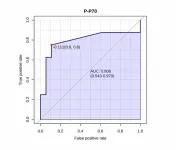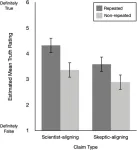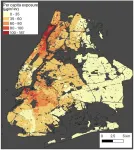(Press-News.org) Researchers working on large artificial intelligence models like ChatGPT have vast swaths of internet text, photos and videos to train systems. But roboticists training physical machines face barriers: Robot data is expensive, and because there aren’t fleets of robots roaming the world at large, there simply isn’t enough data easily available to make them perform well in dynamic environments, such as people’s homes.
Some researchers have turned to simulations to train robots. Yet even that process, which often involves a graphic designer or engineer, is laborious and costly.
Two new studies from University of Washington researchers introduce AI systems that use either video or photos to create simulations that can train robots to function in real settings. This could significantly lower the costs of training robots to function in complex settings.
In the first study, a user quickly scans a space with a smartphone to record its geometry. The system, called RialTo, can then create a “digital twin” simulation of the space, where the user can enter how different things function (opening a drawer, for instance). A robot can then virtually repeat motions in the simulation with slight variations to learn to do them effectively. In the second study, the team built a system called URDFormer, which takes images of real environments from the internet and quickly creates physically realistic simulation environments where robots can train.
The teams presented their studies — the first on July 16 and the second on July 19 — at the Robotics Science and Systems conference in Delft, Netherlands.
“We’re trying to enable systems that cheaply go from the real world to simulation,” said Abhishek Gupta, a UW assistant professor in the Paul G. Allen School of Computer Science & Engineering and co-senior author on both papers. “The systems can then train robots in those simulation scenes, so the robot can function more effectively in a physical space. That’s useful for safety — you can’t have poorly trained robots breaking things and hurting people — and it potentially widens access. If you can get a robot to work in your house just by scanning it with your phone, that democratizes the technology.”
While many robots are currently well suited to working in environments like assembly lines, teaching them to interact with people and in less structured environments remains a challenge.
“In a factory, for example, there's a ton of repetition,” said lead author of the URDFormer study Zoey Chen, a UW doctoral student in the Allen School. “The tasks might be hard to do, but once you program a robot, it can keep doing the task over and over and over. Whereas homes are unique and constantly changing. There’s a diversity of objects, of tasks, of floorplans and of people moving through them. This is where AI becomes really useful to roboticists.”
The two systems approach these challenges in different ways.
RialTo — which Gupta created with a team at the Massachusetts Institute of Technology — has someone pass through an environment and take video of its geometry and moving parts. For instance, in a kitchen, they’ll open cabinets and the toaster and the fridge. The system then uses existing AI models — and a human does some quick work through a graphic user interface to show how things move — to create a simulated version of the kitchen shown in the video. A virtual robot trains itself through trial and error in the simulated environment by repeatedly attempting tasks such as opening that toaster oven — a method called reinforcement learning.
By going through this process in the simulation, the robot improves at that task and works around disturbances or changes in the environment, such as a mug placed beside the toaster. The robot can then transfer that learning to the physical environment, where it’s nearly as accurate as a robot trained in the real kitchen.
The other system, URDFormer, is focused less on relatively high accuracy in a single kitchen; instead, it quickly and cheaply conjures hundreds of generic kitchen simulations. URDFormer scans images from the internet and pairs them with existing models of how, for instance, those kitchen drawers and cabinets will likely move. It then predicts a simulation from the initial real-world image, allowing researchers to quickly and inexpensively train robots in a huge range of environments. The trade-off is that these simulations are significantly less accurate than those that RialTo generates.
“The two approaches can complement each other,” Gupta said. “URDFormer is really useful for pre-training on hundreds of scenarios. RialTo is particularly useful if you've already pre-trained a robot, and now you want to deploy it in someone’s home and have it be maybe 95% successful.”
Moving forward, the RialTo team wants to deploy its system in peoples’ homes (it’s largely been tested in a lab), and Gupta said he wants to incorporate small amounts of real-world training data with the systems to improve their success rates.
“Hopefully, just a tiny amount of real-world data can fix the failures,” Gupta said. “But we still have to figure out how best to combine data collected directly in the real world, which is expensive, with data collected in simulations, which is cheap, but slightly wrong.”
On the URDFormer paper additional co-authors include the UW’s Aaron Walsman, Marius Memmel, Alex Fang — all doctoral students in the Allen School; Karthikeya Vemuri, an undergraduate in the Allen School; Alan Wu, a masters student in the Allen School; and Kaichun Mo, a research scientist at NVIDIA. Dieter Fox, a professor in the Allen School, was a co-senior author. On the URDFormer paper additional co-authors include MIT’s Marcel Torne, Anthony Simeonov, Tao Chen — all doctoral students; Zechu Li, a research assistant; and April Chan, an undergraduate. Pulkit Agrawal, an assistant professor at MIT, was a co-senior author. The URDFormer research was partially funded by Amazon Science Hub. The RialTo research was partially funded by the Sony Research Award, the U.S. Government and Hyundai Motor Company.
For more information, contact Gupta at abhgupta@cs.washington.edu and Chen at qiuyuc@uw.edu.
END
Using photos or videos, these AI systems can conjure simulations that train robots to function in physical spaces
2024-08-07
ELSE PRESS RELEASES FROM THIS DATE:
When is too much knowledge a bad thing?
2024-08-07
CORNELL UNIVERSITY MEDIA RELATIONS OFFICE
FOR RELEASE: August 7, 2024
Kaitlyn Serrao
607-882-1140
kms465@cornell.edu
When is too much knowledge a bad thing?
ITHACA, N.Y. – A new study finds an increase in knowledge could be a bad thing when people use it to act in their own self-interest rather than in the best interests of the larger group.
Cornell University economics professor Kaushik Basu and Jörgen Weibull, professor emeritus at the Stockholm School of Economics, are co-authors ...
Do smells prime our gut to fight off infection?
2024-08-07
Many organisms react to the smell of deadly pathogens by reflexively avoiding them. But a recent study from the University of California, Berkeley, shows that the nematode C. elegans also reacts to the odor of pathogenic bacteria by preparing its intestinal cells to withstand a potential onslaught.
As with humans, nematodes’ guts are a common target of disease-causing bacteria. The nematode reacts by destroying iron-containing organelles called mitochondria, which produce a cell's energy, to protect this critical element from iron-stealing bacteria. Iron is a key catalyst in many enzymatic reactions in cells — in particular, ...
mTORC1 in classical monocytes: Links to human size variation & neuropsychiatric disease
2024-08-07
"This report suggests that a simple assay may allow cost-effective prediction of medication response."
BUFFALO, NY- August 7, 2024 – A new research paper was published in Aging (listed by MEDLINE/PubMed as "Aging (Albany NY)" and "Aging-US" by Web of Science), Volume 16, Issue 14 on July 26, 2024, entitled, “mTORC1 activation in presumed classical monocytes: observed correlation with human size variation and neuropsychiatric disease.”
In this new study, researchers Karl Berner, Naci Oz, Alaattin Kaya, Animesh Acharjee, and Jon Berner ...
In Parkinson’s, dementia may occur less often, or later, than thought
2024-08-07
MINNEAPOLIS – There’s some good news for people with Parkinson’s disease: The risk of developing dementia may be lower than previously thought, or dementia may occur later in the course of the disease than previously reported, according to a study published in the August 7, 2024, online issue of Neurology®, the medical journal of the American Academy of Neurology.
“The development of dementia is feared by people with Parkinson’s, and the combination of both a movement disorder and a cognitive disorder can be devastating to them and their loved ones,” said study author Daniel Weintraub, MD, ...
Impact of drought on drinking water contamination: disparities affecting Latino/a communities
2024-08-07
Long-term exposure to contaminants such as arsenic and nitrate in water is linked to an increased risk of various diseases, including cancers, cardiovascular diseases, developmental disorders and birth defects in infants. In the United States, there is a striking disparity in exposure to contaminants in tap water provided by community water systems (CWSs), with historically marginalized communities at greater risks compared to other populations. Often, CWSs that distribute water with higher contamination levels exist in areas that lack adequate public infrastructure or sociopolitical and financial resources.
In ...
Pesticide exposure linked to stillbirth risk in new study
2024-08-07
Living less than about one-third of a mile from pesticide use prior to conception and during early pregnancy could increase the risk of stillbirths, according to new research led by researchers at the Mel and Enid Zuckerman College of Public Health and Southwest Environmental Health Sciences Center.
Researchers found that during a 90-day pre-conception window and the first trimester of pregnancy, select pesticides, including organophosphates as a class, were associated with stillbirth.
The paper, “Pre-Conception ...
Individuals vary in how air pollution impacts their mood
2024-08-07
Affective sensitivity to air pollution (ASAP) describes the extent to which affect, or mood, fluctuates in accordance with daily changes in air pollution, which can vary between individuals, according to a study published August 7, 2024 in the open-access journal PLOS ONE by Michelle Ng from Stanford University, USA, and colleagues.
Individuals’ sensitivity to climate hazards is a central component of their vulnerability to climate change. Building on known associations between air pollution exposure and ...
Repetition boosts belief in climate-skeptical claims, even among climate science endorsers
2024-08-07
Climate science supporters rated climate-skeptical statements as “truer” after just a single repetition, according to a study published August 7, 2024 in the open-access journal PLOS ONE led by Mary Jiang from The Australian National University, Australia, and coauthored by Norbert Schwarz from the University of Southern California, USA, and colleagues. The results held true even for the strongest climate science supporters surveyed.
Amidst the influx of content that a person consumes each day, the principle of motivated ...
Study quantifies air pollution for NYC subway commuters
2024-08-07
New York City subway commuters who are economically disadvantaged or belong to racial minority groups have the highest exposure to fine particulate matter during their commutes, according to a new study published August 7, 2024 in the open-access journal PLOS ONE by Shams Azad of New York University, USA.
Fine particulate matter (PM2.5) is a type of air pollution that, due to its small size, when inhaled by a person can enter the bloodstream. PM2.5 is known to cause short- and long-term health complications. For the last few decades, cities have promoted public transportation to reduce traffic congestion and improve ambient outdoor air quality. Subway systems reduce pollution by decreasing ...
TikTok videos glamorizing disordered eating behavior and extremely thin body image ideals make women feel worse about their bodies
2024-08-07
Women who spend a lot of time on TikTok — especially those seeing a lot of pro-anorexia content — feel worse about their appearance, a new study shows. The results suggest that high TikTok exposure could harm mental health, reducing body image satisfaction and increasing the risk for disordered eating behavior. Madison Blackburn and Rachel Hogg from Charles Sturt University in Australia present these findings in the open-access journal PLOS ONE on August 7, 2024.
Since its launch, the short-form video app TikTok has had more than 2 billion downloads. The app’s algorithm curates content on a “For ...







